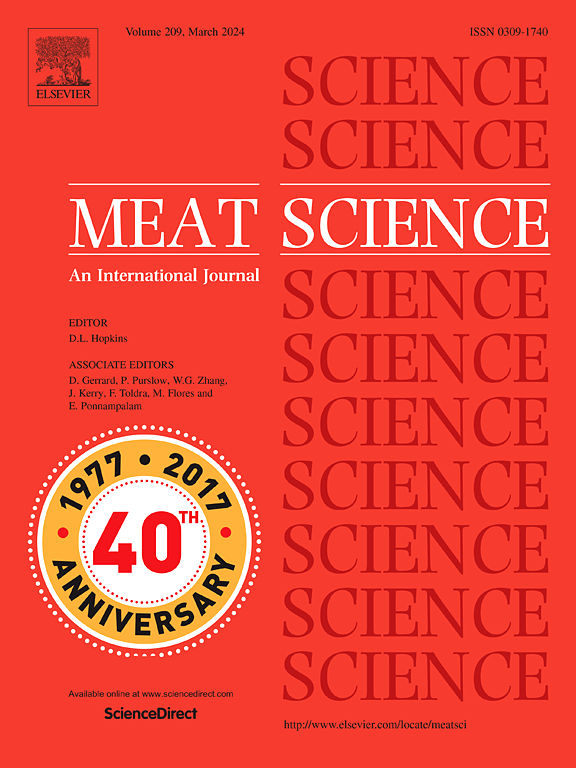使用氯化钠制冷剂和三种氨基酸接触浸泡冷冻冷藏猪肉的能耗和质量改进
IF 6.1
1区 农林科学
Q1 Agricultural and Biological Sciences
引用次数: 0
摘要
保持低能耗和提高冷冻猪肉的质量有助于肉类行业的可持续性。采用23.5%氯化钠(NaCl)溶液作为对照制冷剂(NIF)。研究了用赖氨酸、脯氨酸和精氨酸三种氨基酸代替10%的氯化钠对接触浸泡冷冻猪肉能耗和品质改善的影响。结果表明,3种氨基酸中的l-脯氨酸可以通过减缓制冷剂比热容的增加、导热系数的降低和热扩散系数的降低来缓解NaCl降低引起的猪肉比热容的增加、导热系数的降低和未冻水含量的降低,从而保持NIF组的冷冻节能和效率(缩短冷冻时间)。l-脯氨酸的掺入还能有效降低NaCl对猪肉的渗入,改善猪肉的颜色品质。本研究为肉类行业的接触浸渍冷冻提供了一种新型制冷剂,可降低能耗,提高冻肉品质。本文章由计算机程序翻译,如有差异,请以英文原文为准。
Energy consumption and quality improvement of frozen pork using NaCl refrigerant with three amino acids in contact immersion freezing
Maintaining low-energy consumption and improving the quality of frozen pork contribute to the sustainability of the meat industry. This study used a 23.5 % sodium chloride (NaCl) solution as the control refrigerant (NIF). It investigated the effects of substituting 10 % of NaCl in the refrigerant with three amino acids (l-lysine, l-proline, or l-arginine) on energy consumption and pork quality improvement in contact immersion freezing. Results indicated that l-proline among three amino acids could mitigate the increase in specific heat capacity, the decrease in thermal conductivity, and the unfrozen water content of pork caused by the reduction of NaCl via mitigating the increase in specific heat capacity, the decrease in thermal conductivity, and the thermal diffusion coefficient of the refrigerant, thus maintaining the freezing energy conservation and efficiency (reduced freezing time) of the NIF group. The incorporation of l-proline also effectively reduced NaCl infiltration into the pork and improved its color quality. This study provides a new refrigerant for contact immersion freezing in the meat industry, offering low-energy consumption and improved frozen meat quality.
求助全文
通过发布文献求助,成功后即可免费获取论文全文。
去求助
来源期刊

Meat Science
工程技术-食品科技
CiteScore
12.60
自引率
9.90%
发文量
282
审稿时长
60 days
期刊介绍:
The aim of Meat Science is to serve as a suitable platform for the dissemination of interdisciplinary and international knowledge on all factors influencing the properties of meat. While the journal primarily focuses on the flesh of mammals, contributions related to poultry will be considered if they enhance the overall understanding of the relationship between muscle nature and meat quality post mortem. Additionally, papers on large birds (e.g., emus, ostriches) as well as wild-captured mammals and crocodiles will be welcomed.
 求助内容:
求助内容: 应助结果提醒方式:
应助结果提醒方式:


